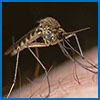Home About Us Team Products News Contact FAQ

A90-A99 Arthropod-Borne Viral Fevers & Viral Hemorrhagic Fevers
A90
Dengue Fever (Classical Dengue)
A91
Dengue Hemorrhagic Fever
A92 Other Mosquito-Borne Viral Fevers
A92.0
Chikungunya Virus Disease
A92.1
O'nyong-nyong Fever
A92.2
Venezuelan Equine
Fever
A92.3
West Nile Virus Infection
A92.4
Rift Valley
Fever
A92.5
Zika Virus
A92.8
Other Specified Mosquito-Borne Viral Fevers
A92.9
Mosquito-Borne Viral Fever-Unspecified
A93 Other Arthropod-Borne Viral Fevers-Not Elsewhere Classified
A93.0
Oropouche Virus Disease
A93.1
Sandfly Fever
A93.2
Colorado Tick Fever
A93.8
Other Specified Arthropod-Borne Viral Fevers
A94
Unspecified Arthropod-Borne Viral Fever
Arthropod-borne viral fevers and viral hemorrhagic fevers A90-A99 >
Dengue fever [classical dengue] A90- >
Type 1 Excludes
dengue hemorrhagic fever (A91)
Clinical Information
Acute infectious, eruptive, febrile disease caused by four
antigenically related but distinct serotypes of the dengue
virus; transmitted by the bite of infected aedes mosquitoes,
especially a. Aegypti; classical dengue (dengue fever) is
self-limiting and characterized by fever, myalgia, headache,
and rash; dengue hemorrhagic fever is a more virulent form of
dengue virus infection.
An acute febrile disease transmitted by the bite of aedes
mosquitoes infected with dengue virus. It is self-limiting
and characterized by fever, myalgia, headache, and rash.
Dengue hemorrhagic fever is a more virulent form of dengue.
An acute infection caused by dengue virus. Signs and symptoms
include sudden onset of fever, headache, rash, arthralgia,
and myalgia. It is transmitted through mosquitoes.
An acute, infectious tropical disease caused by an
arbovirus transmitted by mosquitoes
Dengue is an infectious disease caused by a virus.
You can get it if an infected mosquito bites you. It is
common in warm, wet areas of the world. Outbreaks occur in
the rainy season. Dengue is rare in the United States.
Symptoms include a high fever, headaches, joint and muscle
pain, vomiting and a rash. Most people with dengue recover
within 2 weeks. Until then, drinking lots of fluids, resting
and taking non-aspirin fever-reducing medicines might help.
Sometimes dengue turns into dengue hemorrhagic fever, which
causes bleeding from your nose, gums or under your skin. It
can also become dengue shock syndrome, which causes massive
bleeding and shock. These forms of dengue are life-threatening.
to lower your risk when traveling in dengue-prone countries
wear insect repellent with deet
wear clothes that cover your arms, legs and feet
close unscreened doors and windows
Dengue hemorrhagic fever A91- >
Clinical Information
A serious condition caused by dengue virus infection. Patients
present with an acute febrile illness followed by restlessness,
irritability, and bleeding. It may lead to hemorrhagic shock
and death.
A virulent form of dengue characterized by thrombocytopenia
and an increase in vascular permeability (grades i and ii)
and distinguished by a positive pain test (e.g., tourniquet
pain test). When accompanied by shock (grades iii and iv),
it is called dengue shock syndrome.
Unspecified arthropod-borne viral fever A94- >
Applicable To
Arboviral fever NOS
Arbovirus infection NOS
Clinical Information
Infections caused by arthropod-borne viruses, general
or unspecified.
Yellow fever A95- >
Clinical Information
A disease caused by infection with the yellow fever virus, which
is carried by mosquitos. Symptoms include body aches,
chills, fever, severe headache, weakness, and a yellow skin
color. Bleeding, vomiting, and failure of the liver and other
organs may occur in late stages of the disease.
A tropical disease transmitted by mosquito bites
A viral infection caused by a flavivirus called yellow fever
virus. It is transmitted to humans from infected mosquitoes.
The signs and symptoms range from a mild febrile illness to
liver damage with jaundice and hemorrhages.
Acute infectious disease primarily of the tropics, caused
by a flavivirus and transmitted to humans by mosquito vectors.
An acute infectious disease primarily of the tropics, caused
by a virus and transmitted to man by mosquitoes of the genera
aedes and haemagogus.
Unspecified viral hemorrhagic fever A99- >
Clinical Information
A group of viral diseases of diverse etiology but having
many similar clinical characteristics; increased capillary
permeability, leukopenia, and thrombocytopenia are common
to all. Hemorrhagic fevers are characterized by sudden
onset, fever, headache, generalized myalgia, backache,
conjunctivitis, and severe prostration, followed by various
hemorrhagic symptoms. Hemorrhagic fever with kidney
involvement is hemorrhagic fever with renal syndrome.
Syndrome that occurs in perhaps 20-40 percent of infections
by a number of different viruses of the families arenaviridae,
bunyaviridae, flaviviridae, filoviridae, etc; some types of
hemorrhagic fever are tick borne, others mosquito borne,
and some seem to be zoonoses; clinical manifestations are
high fever, scattered petechiae, gastrointestinal tract and
other organ bleeding, hypotension, and shock; kidney damage
may be severe and neurologic signs may appear.
Viral hemorrhagic fevers (vhfs) are a group of illnesses
caused by four families of viruses. These include the ebola
and marburg viruses and lassa fever virus. Vhfs have common
features: they affect many organs, they damage the blood
vessels and they affect the body's ability to regulate itself.
Some vhfs cause mild disease, but some, like ebola or marburg,
cause severe disease and death.vhfs are found around the world.
Specific diseases are usually limited to areas where the animals
that carry them live. For example, lassa fever is limited to
rural areas of west africa where rats and mice carry the virus.
the risk for travelers is low, but you should avoid visiting
areas where there are disease outbreaks. Because there are no
effective treatments for some of these viral infections, there
is concern about their use in bioterrorism.
A96 Arenaviral Hemorrhagic Fever
A96.0
Junin Hemorrhagic Fever
A96.1
Machupo Hemorrhagic Fever
A96.2
Lassa
Fever
A96.8
Other Arenaviral Hemorrhagic Fevers
A96.8
Other Arenaviral Hemorrhagic Fevers
Lujo Hemorrhagic Fever (LUHF)
A96.9
Arenaviral Hemorrhagic Fever-Unspecified
A98 Other Viral Hemorrhagic Fevers-Not Specified Elsewhere
A98.0
Crimean-Congo Hemorrhagic
Fever
A98.1
Omsk
Hemorrhagic
Fever
A98.2
Kyasanur Forest Disease
A98.3
Marburg Virus Disease
A98.4
Ebola Virus Disease
A98.5 Hemorrhagic Fever with Renal Syndrome
A98.8
Other Specified Viral Hemorrhagic Fevers
A99
Unspecified Viral Hemorrhagic Fever
™


.png?crc=4187891543)
